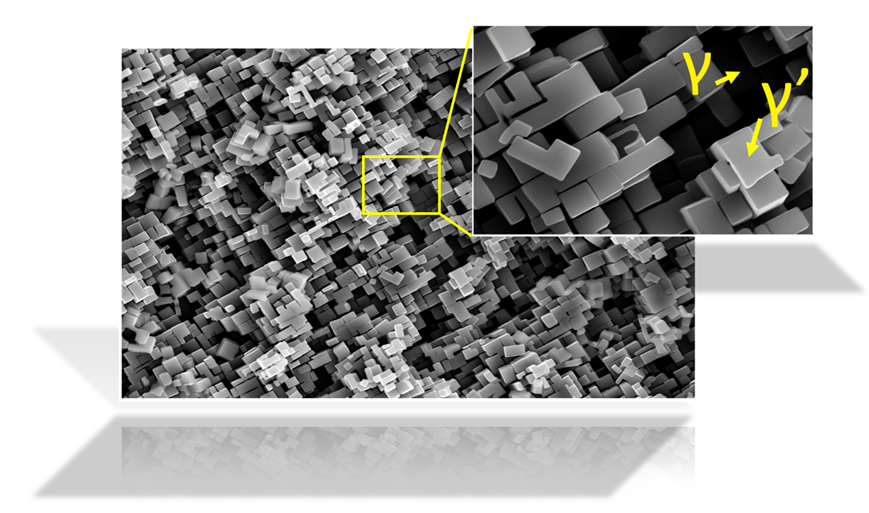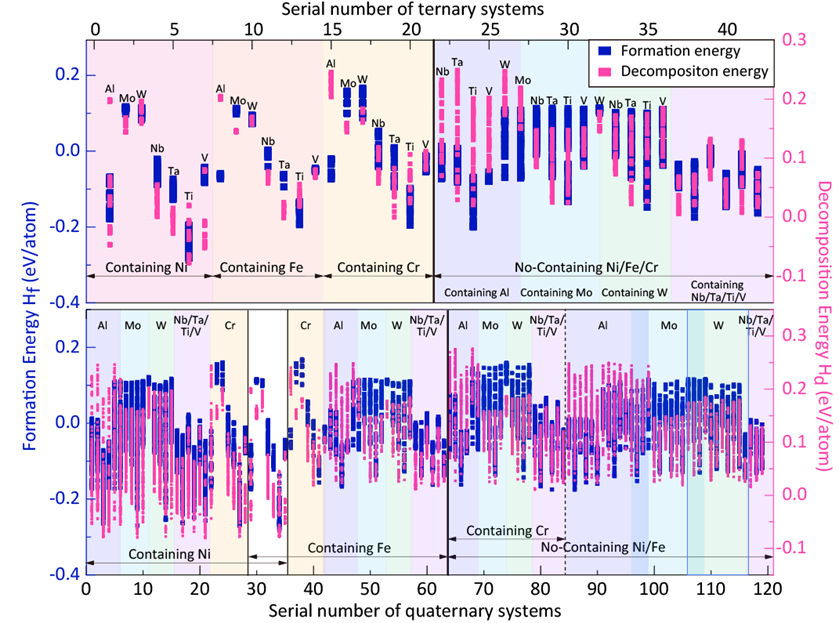AI Meets Alloy Design: Discovering more New Cobalt-Based Superalloys for the Next Generation

Superalloys are essential materials for the hot-end components of aircraft engines, with nickel-based superalloys being widely used due to their unique γ/γ′ dual-phase microstructure and excellent high-temperature mechanical properties. However, the thermal tolerance limits of nickel-based superalloys have sparked interest in exploring alternative materials for next-generation high-performance alloys. The discovery of the novel γ/γ′ Co-Al-W alloy has reignited interest in cobalt-based superalloys, offering potential advantages over traditional nickel-based counterparts. In the search for new γ/γ′ cobalt-based superalloy systems, traditional methods often face challenges such as lengthy development cycles and high costs due to trial-and-error experimentation.
To address these challenges, our research team combined Density Functional Theory (DFT) calculations with machine learning modeling to efficiently navigate the large compositional space. This approach led to the identification of several promising cobalt-based alloys with theoretical γ/γ′ dual-phase structures. We then experimentally synthesized two of these newly identified alloys. Our findings have been published in npj Computational Materials, a journal by Springer Nature.

Challenge:How to Rapidly Identify New γ/γ′ Cobalt-Based Alloys in the Vast Alloy Composition Space?
Traditional elemental substitution and experimental trial-and-error development are expensive and take a long time, and the advent of the data age is expected to accelerate the development process of superalloys. Machine learning has already made significant strides across various research fields. However, its application in the realm of alloy materials, particularly when combined with Density Functional Theory (DFT) calculations, is still relatively rare. While much of the research on superalloys has focused on nickel-based systems, cobalt-based alloys remain underexplored, with challenges such as long development cycles and high costs hindering progress.
When integrating machine learning into cobalt-based alloy research, the novelty and complexity of the system pose additional challenges, particularly in data collection. Most existing studies rely on pre-existing databases to build models, focusing on optimizing specific components or structural characteristics. Moreover, many machine learning applications in this field are still largely theoretical, with limited reports on experimental validation and accuracy.
Given the vastness of the alloy composition space, the question of how to efficiently discover more γ/γ′ cobalt-based alloy systems with new phase structures has become a key focus for researchers.
Our Approach: DFT + ML
We focused our efforts on an extensive alloy space composed of 11 common alloying elements. In these systems, the formation and stability of the γ′ phase are strongly influenced by energy factors. To assess the likelihood of γ′ phase formation across different systems, we calculated the formation energy to gauge synthesis feasibility and used the energy convex hull principle to evaluate phase stability, building a decomposition energy dataset specifically for this purpose.
To address the challenges of data collection for novel cobalt-based alloy systems, we employed high-throughput Density Functional Theory (DFT) calculations to generate energy data for all γ′ phases in our system. For accurate modeling and predictions, we trained our energy models using a carefully selected regression framework, incorporating both random forest algorithms and a multidimensional feature engineering approach.
Using these trained models, we were able to predict the energy values of over 150,000 unknown γ′ phases within the Co-Ni-Fe-Cr-Al-W-Ti-Ta-V-Mo-Nb system. We then identified thermodynamically stable systems and validated these predictions further with CALPHAD assessments and experimental characterization, affirming the robustness of our findings.
Key Results and Applications
Our findings provide valuable insights for the rapid search and identification of new γ/γ′ cobalt-based superalloys. This approach not only accelerates the discovery process but also uncovers the mechanisms by which certain elements influence the stability of the γ′ phase.
Our trained random forest model achieved an impressive prediction accuracy of 98.07% for the formation energy (Hf) and 97.05% for the decomposition energy (Hd). We found that elements such as Ni, Nb, Ta, Ti, and V enhance the stability of the γ′ phase, while Mo, W, and Al negatively impact stability by increasing the decomposition energy (Hd).
From over 150,000 potential compositions predicted to form stable γ′ phases, we identified 1,049 promising candidates, primarily distributed across 11 aluminum-containing and 25 non-aluminum alloy systems.
Two novel cobalt-based alloys with a γ/γ′ dual-phase microstructure were synthesized, validating the reliability of our trained models. Moreover, the γ′ phase stability of the two alloys exceeded our expectations, and remained stable even at higher temperatures and long-term aging treatments. Both alloys achieved a minimum density of 7.90 g/cm³, which is better than most existing cobalt-based alloys. These results not only highlight the power of our approach but also contribute to the advancement of next-generation cobalt-based superalloys.

 Future Research Directions
Future Research Directions
In conclusion, our study combines DFT and machine learning techniques to accelerate the search for novel γ/γ′ cobalt-based superalloys. Additionally, we have experimentally validated the potential of machine learning methods in the development of new cobalt-based superalloys.
However, our results also show that although the two alloys have great potential, their comprehensive properties need to be improved. Future research will focus on further optimizing the composition and microstructure of the newly developed cobalt-based superalloys. Our goal is to explore the potential of combining machine learning with advanced computational models to predict and tailor material properties for specific high-temperature applications. We will also delve deeper into the interpretability of prediction models, seeking to uncover the "genetics" of material properties.
Furthermore, combining experimental validation with predictive modeling is crucial for confirming alloy performance under real-world conditions. Future studies will also explore the scalability of these alloys in industrial manufacturing processes, as well as their long-term performance under extreme operational conditions. By continuously refining our methods and integrating new data, we aim to enhance the stability, durability, and overall functionality of these alloys, making them a more reliable option for aerospace and other high-performance industries.
Follow the Topic
-
npj Computational Materials

This journal publishes high-quality research papers that apply computational approaches for the design of new materials, and for enhancing our understanding of existing ones.
Related Collections
With Collections, you can get published faster and increase your visibility.
Recent Advances in Active Matter
Publishing Model: Open Access
Deadline: Sep 01, 2026
Computational Catalysis
Publishing Model: Open Access
Deadline: Dec 31, 2025

Please sign in or register for FREE
If you are a registered user on Research Communities by Springer Nature, please sign in